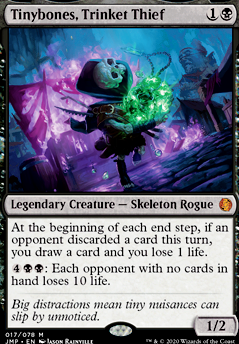I use the following ten parameters to determine the strength of the deck. For each, I allocate a score of 5 (very good), 4 (good), 3 (mediocre), 2 (bad) or 1 (very bad); when totalized this score represents the power rating of the deck (maximum score is 50 points).
- Mana: indicates the availability of mana sources within the deck.
- Ramp: indicates the speed at which mana sources within the deck can be made available.
- Card Advantage: indicates availability of filter- and draw resources represented within the deck.
- Overall speed: indicates the deck’s potential for pace, based on resource availability and mana curve.
- Combo: indicates the measure of combo-orientation of the deck.
- Army: indicates the deck’s creature-army strength.
- Commander: indicates how much the deck is commander-oriented/dependent (less dependency is better).
- Interaction: indicates how much this deck can mess with opponents’ board states and turn-phases.
- Resilience: indicates whether the deck can prevent and take punches.
- Spellpower: indicates the availability and strength of high-impact spells.
Mana: 4
The deck contains six mana rocks, a spell that provides an instant mana boost, a creature that doubles my swamps’ output and two permanents that can provide additional mana when I am forced to discard a land.
Ramp: 1
I have a single creature than upon sacrificing, allows me to search for a land. It’s not much, but it adds nicely to my other options that extend my mana base. I also use a land to play other lands.
Card Advantage: 5
Holy cow, this deck can give me some very nice card advantage (especially for a non-blue deck)! First off, my commander enables me to draw, if I force others to discard. The deck contains six other permanents and spells that will result in direct draw for me. Then there are four different tutors (one of them repeatable!), one creature that top-decks for life and no less than three permanents that allows me to steal from graveyards for hardly any cost!
Overall speed: 5
Almost half of this deck’s cards (forty-six!) have a CMC of three or less. When I combine this with the deck’s availability of mana sources AND its magnificent card advantage options I get a mono-colored deck with almost optimal speed.
Combo: 2
Nope. This deck just isn’t about that. It is however all about lots of synergy between my ability to force others to discard while I make that hurt (a lot) AND profit from that at the same time.
Army: 2
In retrospect, I don’t have all that many decks in which the army doesn’t play a very important part. This is one of them. Attacking is in no way required in order to make life very difficult for the opposition. Yet, having some of the deck’s creatures’ utility abilities available can still be instrumental in attaining victory.
Commander: 4
Though Tinybones, Trinket Thief is absolutely awesome and accelerates my ability to win, he/she is not super necessary for that. Plenty of other ways to get card advantage or deal damage in this deck.
Interaction: 5
During my opponents’ turns, I can mess around with their ability to cast by forcing discards or milling (through the use of five permanents), I can force them to take actions that will cost them life and in some cases raise my own (six permanents), I can steal creatures through discarding actions of my opponents and even boost some of my creatures this way (four permanents in total). Aside from all this, I can force my opponents to discard a lot more through sorceries and permanents during my own turns, through a plethora of cards.
Resilience: 2
Discarding is not necessarily bad for me. At least four permanents in the deck can be used to extract something useful (mana, life, tokens) for every discard, so discarding is not necessarily a full loss. One option even prevents me from having to discard into my graveyard and there’s a fair few cards in here that allow me to recoup some lost life.
Spellpower: 4
This deck is much more adept at slinging nasty, warped reality at you than it is at building armies. Its most effective weapons in that regard are fourteen enchantments and ten sorceries that will either force discards, inflict nasty consequences of discarding or just deal a shit-ton of damage.
Total power score: 34
This deck is one of my strongest single-color decks and scores well above average strength. The reason it stands out is a combination of its speed, spell-slinging capabilities and most importantly: its capability to negate the casting of opposing spells by getting rid of them before that can happen. Its army is not strong, but it (usually) does not need to be. Its ramp is a bit lacking, but considering the low mana curve that’s usually not an issue either.


